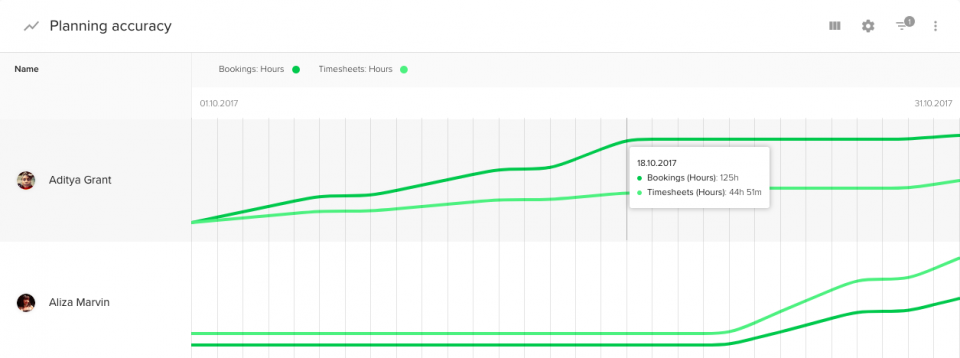资源日历--用一个工具管理整个团队
资源日历(或项目管理日历、或项目规划日历、资源规划软件)可让您更有效、更高效地规划、管理和分配资源--尤其是如果 Microsoft Excel 在您的项目中发挥了主导作用。
任何曾经管理过团队或公司的人都会告诉你,如果没有计划好由谁来做以及何时可以完成,要完成一个项目是非常困难的。 然而,许多公司却依赖于临时 资源分配 以及 "希望一切顺利 "的态度。
这篇文章让读者得到了什么?
事实上,只有 62% 个组织 项目管理协会调查 承认他们总是或经常使用资源管理来估算和分配资源。
尤其令人担忧的是 同一项研究 表明,资源分配不足是许多项目面临风险的原因。当被问及过去项目失败的主要原因时,23% 的受访者提到了 "资源预测不足 "和 "资源依赖"。
诚然,这不是最常见的问题,但与 "组织优先事项的变化"(41% 的受访者提到)相比,资源规划似乎是一个非常由你掌控的因素。
对于专注于发展的年轻公司来说,资源管理可能并不是最需要关注的事情。
然而,当出现上述增长时,他们就必须迅速加强调度工作,以实现蓬勃发展。对于同时兼顾多个项目的公司(如代理公司、咨询公司或软件公司)来说,尤其如此。

资源分配不足会导致沟通混乱,给项目带来风险。
无论团队规模大小,我都非常提倡建立资源管理流程。事实上,深思熟虑的团队规划可以在早期加速你的成长,并保持公司的健康发展。
让我们来介绍一下为享受资源管理带来的好处而需要采取的最重要步骤。
许多团队都在为团队能见度有限而苦恼,这导致员工工作过度、项目延误或不同项目经理之间沟通不畅。
无论公司规模大小,全球资源日程表都是必不可少的。您是公司资源分配的唯一负责人吗?作为项目经理,我们深知工作量管理的重要性)。
员工列表是一个开始,但我强烈建议分配一些属性,如职称、资历或工作地点(如果您的工作地点在 虚拟团队),这样就可以轻松筛选资源。尚未与特定团队成员合作过的项目经理不一定了解他们的技能,因此这种带有自定义标签的全局项目进度表可以帮助他们决定为某个项目指派谁。

在努力提高资源分配效率时,你必须牢记的另一件事就是工作量。公司过度依赖某些员工,而忽略其他可以完成特定任务的员工的情况并不少见。通过查看日程表,你可以发现哪些人工作过度,哪些人利用率不足,然后对他们的任务进行合理分配。

销售和产品团队也会对团队能见度的提高表示赞赏。在洽谈新交易或决定为您的应用程序添加更多功能时,他们可以对时间做出明智的决定。
比方说,你有三名内部设计师,他们没有紧迫的任务,因此可以为新赢得的项目工作。如果只考虑工作量的安排,你就可以开始工作了,甚至可以说是别无选择。然而,其中一位设计师请了病假,另一位设计师正在休假,第三位设计师刚刚要求在本月兼职工作。
就这样,您的项目就会面临风险,您可能需要推迟项目或外包额外的设计师。这两种选择通常都会影响您的底线。
深入了解团队的可用性对于成功分配资源至关重要。
无论你的员工是长期请假还是只请半天假,你和你的项目经理都需要知道谁能切实承担新任务。
理想情况下,您可以在一个日程表中同时显示团队的任务和可用性数据,这样您在规划项目时就可以同时考虑到这两个因素。请经常与您合作的兼职员工和自由职业者与您分享他们的日常可用性。

Teamdeck 的工作方式是,员工可以自行输入自己的空闲时间,甚至可以申请休假。然后,经理会接受或拒绝他们的请求,并立即更新日程表。

资源预测和分配是一门科学,也是一门经验。为了充分利用这一公式中的科学部分,你应该开始使用历史数据--这很明显,但绝不简单。
对许多公司来说,跟踪时间是他们与客户达成的共识。还有一些公司则认为这是公司的老古董,不太适合他们正在建立的悠闲文化。
我对时间跟踪的立场是,如果操作得当,对员工来说不会造成干扰,对管理者来说也能有所启发。我建议实时跟踪工作,或至少在同一天填写考勤表。这样可以提高数据的准确性。
在为新项目分配资源时,要分析团队成员在以前任务中所记录的时间。如果他们一再超过 预计时间而且,它们可能不适合时间紧迫的项目。

另外,您还可以评估团队的利用率(通过比较员工的预订和工时表),看看哪些员工在最近的项目中被过度利用。也许有必要雇佣一个具备类似技能的新人。

您可能已经勾选了所有选项,并为您的团队制定了最佳时间表。 但不可避免的是,有些事情会发生变化,影响你的计划:可能是项目的范围,也可能是项目的时间表。有人可能会生病或在项目中期退出公司。
做好应对变化的准备,并能在面临变化时迅速采取行动,这一点至关重要。有一件事可以帮助我的公司同时管理多个不同的项目,那就是我们的实时日程表。每个项目经理都能看到每个人当前的可用性和工作量。
在项目启动前精心准备的电子表格和文件有一个问题。一旦有什么变化,它们就会过时。对于大多数项目来说,这真的很快。你能控制的只有这么多,所以最好准备好迎接变化。